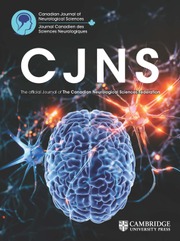Article contents
Arterial Onyx Embolisation of Intracranial DAVFs with Cortical Venous Drainage
Published online by Cambridge University Press: 02 December 2014
Abstract
To present our experience with the endovascular management of intracranial dural arteriovenous fistulas with direct cortical venous drainage by trans-arterial embolisation using Onyx.
Between January 2004 and April 2008, 12 consecutive high grade intracranial dural arteriovenous fistulas (Cognard type III (eight patients) or IV (three patients)) were treated by trans-arterial embolisation with Onyx. The majority of cases were treated by Onyx embolisation alone. One case had additional embolisation with n-butyl-2-cyanoacrylate at the same session. Imaging follow-up was obtained in all but one patient (mean 3.6 months).
Nine patients had a technical success at the end of the embolisation procedure with complete angiographic exclusion of the fistula. Two patients had a small residual fistula at the end of embolisation, one of which had residual mild cortical venous drainage. Both were stable at follow-up angiography. One patient had a residual fistula supplied by the ophthalmic artery, which was thought to be unsafe to embolise and was sent for surgery, which was curative. In one patient the microcatheter ruptured, with a fragment of the distal microcatheter left in the occipital artery. No clinical complications were observed in this series at clinical follow-up (mean 3.3 months). Two patients were noted to have significant radiation dose.
Endovascular management of intracranial dural arteriovenous fistulas with direct venous cortical drainage by trans-arterial Onyx embolisation is a safe and effective treatment according to our experience. Fluoroscopy times and radiation dose may be a concern.
- Type
- Original Article
- Information
- Copyright
- Copyright © The Canadian Journal of Neurological 2009
References
- 16
- Cited by


